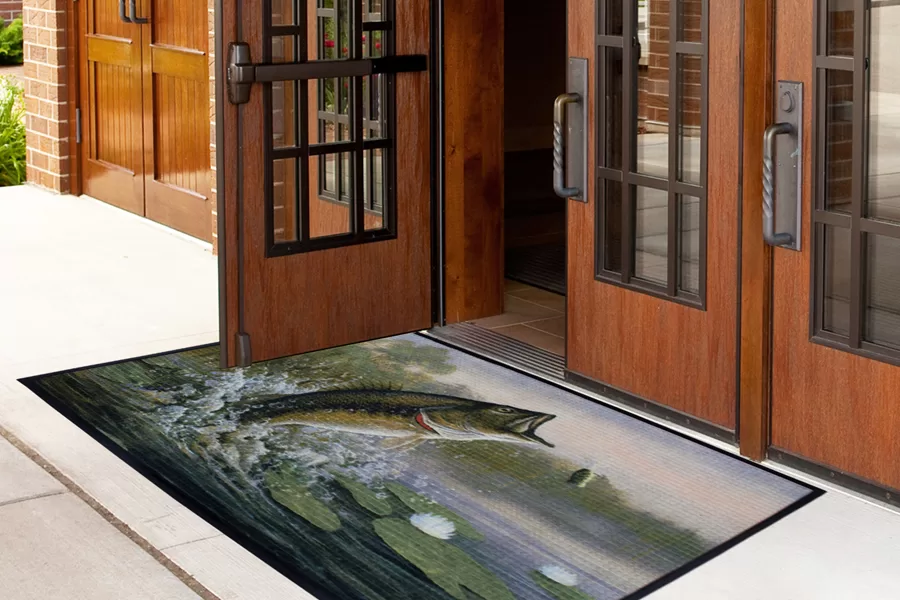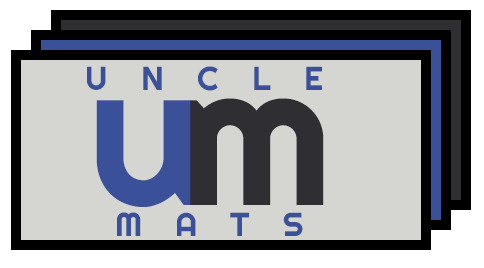We recommend vector graphic files for the best result, AI, EPS, or PDF being the most common. Various other files are accepted, including JPG, PNG, and TIFF; please see the chart below. For carpeted mats, 150 to 300 DPI/PPI is required. For rubber mats, a minimum of 921 DPI/PPI is required. To help ensure your design submissions is processed quickly and printed at the highest quality.
Acceptable
Vector Graphic Files:
AI, EPS, PDF, CDR, SVG
Image Files
TIFF (150-921 DPI/PPI)*
JPG (150-921 DPI/PPI)*
PNG (150-921 DPI/PPI)*
* - For Carpeted Mats, 150 to 300 DPI/PPI is required. For Rubber Mats,, a minimum of 921 DPI/PPI is required.
You can request logo mat proofs in one of two ways, detailed below.
The quickest way to submit artwork is by using our Custom Logo Mat Request submission tool.
By emailing our customer service department, info@unclemats.com.
When you receive your first design proof, it will come from jason@unclemats.com. You can request changes to that artwork by simply reply to that email with your requested changes.
Please be sure that the Design number is noted within the email.


Once you are setup as an Uncle Mats customer you can place an order in several different ways:
Online at www.UncleMats.com (https://unclemats.com/shop/)
Via email or phone. Contact Us here.
You can also request a shipping/freight quote by emailing or calling our Customer Service team.
Uncle Mats offers the following shipping methods:
UPS and FedEx
USPS (military and diplomatic zip codes only – APO, FPO, and DPO)
Various LTL freight carriers
Lead time varies based on the product(s) ordered. However, most Standard orders ship within 3 to 5 business days. Custom Logo mats typically take about 7-10 business days. Select mats are stocked and available to ship quickly (typically same-day or next-day depending on when the order is received).
Please note that for your order to ship same-day or next day, it must contain only stocked items. Including non-stocked items in your order will delay shipping of your order until production of your non-stocked items is complete.
All delivery dates are based on the selected shipping company. Fedex, UPS, DHL, and USPS packages can be tracked through the tracking number provided. Freight shipments will call one day before delivery to schedule the time for the shipment to arrive. All delivery dates and times are estimates.
Upon delivery of your order, please visually inspect the condition and entirety of your shipment, making sure to make note if any items are missing or damaged. The order confirmation email you received lists all the materials and quantities you ordered.
The mats listed above are made with solution-dyed nylon yarn. Because of this, they have excellent colorfastness when exposed to bleach, high temperature, high pH laundering, and direct sunlight. Should your solution-dyed nylon mats become dull or dingy due to soil buildup or dye redeposition, the following clean-up formula can be used. This formula should never be used on any non-solution dyed mats, nor should this formula be used as a regular wash formula. Repeated exposure to high temperatures and chlorine bleach used in this formula can damage the yarn and/rubber backing.
Flush 2 to 3 minutes, medium water level, 120° F (49° C)
Flush 2 to 3 minutes, medium water level, 120° F (49° C)
Break* 20 minutes, high water level, 170° F (76° C)
*Add 16 fluid ounces of 12% active bleach, 2 pounds of sodium carbonate, and 8 ounces chelating agent (EDTA or Calgon) per 100 pounds of mats.
Rinse* 2 minutes, high water level, 120° F (49° C)
*Add 1 pound of antichlor (1% acetic acid or 1% sodium bisulfate) per 100 pounds of mats.
Rinse 2 minutes, high water level, cold.
CAUTION: It is essential to use an antichlor in the final rinse to stop the activity of the chlorine in the bleach. Failure to use antichlor will cause damage to the solution-dyed nylon yarn.
The success of this clean up formula is dependent on the severity of the cross stain and the condition of the carpet fibers. Old mats that have been stained for a long period of time will not clean up as well as mats that were recently stained.
In cases where staining is severe, the bath temperature can be increased to 180°F (82°C) and the break time extended to 40 minutes. These measures should be used as a last resort as there is potential to damage the carpet fibers when using these higher temperatures and longer break times.
Customer experience has shown that certain mat colors in the light blue, silver and gray shades can turn brown, yellow or green when laundered. This problem seems to vary depending upon local water conditions. Some customers have no problems in this area while others experience significant difficulties. The yellowing/discoloration is not unique to any manufacturer. While we have not been able to eliminate the problem, we do have a treatment that in most cases will at least partially reverse the problem.
The cleanup formula shown below can be run as a separate formula assuming that all mats are clean.
Flush 5 minutes, high water level, 120° F (49° C)
Break* 25 minutes, low to medium water level, 140° F (60° C)
*Add 4 pounds of sodium percarbonate or 48 fluid ounces of hydrogen peroxide (35% active ingredients)
Rinse 2 minutes, high water level, 100° F (38° C)
Rinse 2 minutes, high water level, 100° F (38° C)
Maintenance: To keep mats from discoloring, during the break cycle of your regular wash formula add 1/3 to 1/2 pound of sodium per carbonate or 5 to 10 fluid ounces of hydrogen peroxide (35% active ingredients) per 100 pounds of mats.
Safety Note: Hydrogen peroxide is an oxidizing agent. It can cause spontaneous combustion if it encounters wood, leather, or other organic materials. Be sure to use appropriate protective safety equipment and observe all manufacturers’ safety precautions.
The surface flammability of carpet can be tested in several ways. The most common testing methods for small carpets/rugs are DOC FF1-70, commonly called the "pill test," and DOC FF2-70. With DOC FF1-70, eight 9" x 9" specimens are tested. A hole is cut in each one and a tablet (often referred to as a pill) is placed on the mat and ignited. If the charred area does not extend to within one inch of the edge of the hole on at least seven of the eight samples, the mat meets the criterion.
Other flammability testing standards include BS 4790, ISO 11925-2, and ISO 9239-1.
There are many test methods used to determine slip resistance including the British Pendulum test (ASTM E303), NFSI 101-C, dynamic coefficient of friction (ES 13893), and static coefficient of friction testing (ASTM C1028).
For ASTM E303, the British Pendulum test, a dynamic pendulam impact tester is used to measure the "skid resistance" or frictional properties of a test surface. The test measures the energy loss when a rubber edge slider is propelled over the surface. The sample is tested in four directions with the average British Pendulum Number (BPN) reported. A lower BPN indicates a more slippery surface. BPNs are generally equated to the following: 0-24 equates to high slip potential, 24-26 equates to moderate slip potential, 36+ equates to low slip potential.
For ES 13893, the dynamic coefficient of friction (DCOF) is measured using a specified heel assembly. The assembly with a 10-kilogram load is pulled horizontally with a tensile tester to measure the force required to cause the assembly to slip. After the sample is tested for five pulls in the traverse and cross directions, measurements are calculated and reported as dynamic coefficient of friction.
For ASTM C1028, the static coefficient of friction (SCOF) is measured using a neolite heel assembly. The assembly with a 50-pound load is pulled horizontally across the mat with a dynamometer. The dynamometer measures the force required to cause the assembly to slip. The higher the number, the more slip resistant the surface. For reference, a rubber tire on dry pavement has a SCOF of 0.90. For surfaces to be considered slip resistant by ASTM C1028, the SCOF must be 0.60 or above.
The hardness of a surface is measured by means of a Type A Shore Durometer. The durometer measures the penetration of a specified indentor forced into the mat under specified conditions. The lower the reading, the softer the material.
Compression deflection is a measurement designed to assess and compare performance characteristics of anti-fatigue mats. Two specific loads, typically 20 psi and 40 psi, are applied to the mat and the deflection is measured. 20 psi is equivalent to a 150-pound person; 40 psi is equivalent to a 600-pound person. Test results are reported as a percentage.
Studies suggests that surfaces with a compression deflection of less than 20% are perceived as too hard, and surfaces greater than 60% are perceived as too soft. Mats with a compression deflection between 20% and 60% tend to provide the most anti-fatigue benefits.
Electrical resistance is measured to determine a mat's electrostatic discharge (ESD) rating. In the ANSI/ED S7.1 testing method, measurements are made from the mat's surface to groundable points (surface to ground), and from the mat's surface to other areas of the mat's surface (surface to surface). Since humidity (moisture content in the air) effects static electricity, both tests are performed at varying humidity, typically 50% and 12%. The results are measured in ohms. The lower the resistance, the more quickly static electricity is accepted by the mat.
A reading of 101 to 105 ohms means the mat accepts static very quickly and earns a rating of electrically conductive.
Mats with a reading of 106 to 109 ohms are in the mid-range and earn a rating of static dissipative.
A reading of 1010 to 1012 ohms means the mat is more resistant to static and earns a rating of anti-static.




